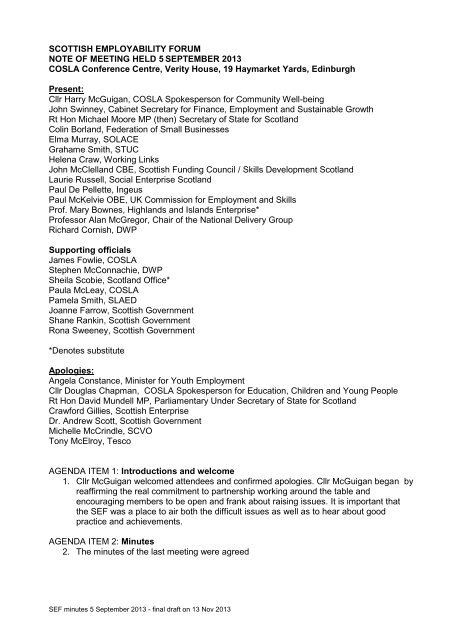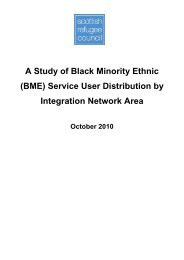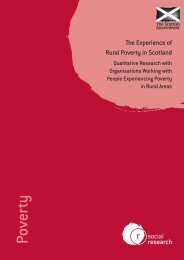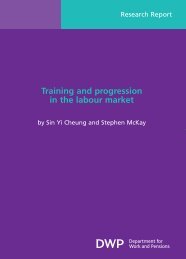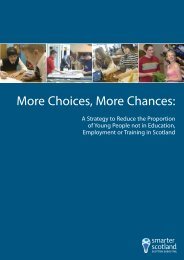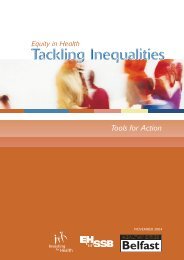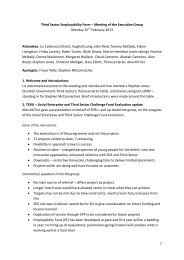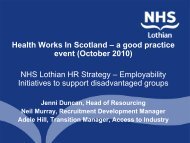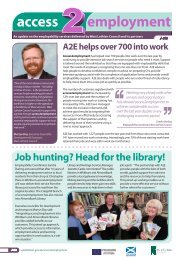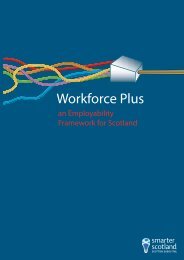Note of meeting - Employability in Scotland
Note of meeting - Employability in Scotland
Note of meeting - Employability in Scotland
You also want an ePaper? Increase the reach of your titles
YUMPU automatically turns print PDFs into web optimized ePapers that Google loves.
SCOTTISH EMPLOYABILITY FORUMNOTE OF MEETING HELD 5 SEPTEMBER 2013COSLA Conference Centre, Verity House, 19 Haymarket Yards, Ed<strong>in</strong>burghPresent:Cllr Harry McGuigan, COSLA Spokesperson for Community Well-be<strong>in</strong>gJohn Sw<strong>in</strong>ney, Cab<strong>in</strong>et Secretary for F<strong>in</strong>ance, Employment and Susta<strong>in</strong>able GrowthRt Hon Michael Moore MP (then) Secretary <strong>of</strong> State for <strong>Scotland</strong>Col<strong>in</strong> Borland, Federation <strong>of</strong> Small Bus<strong>in</strong>essesElma Murray, SOLACEGrahame Smith, STUCHelena Craw, Work<strong>in</strong>g L<strong>in</strong>ksJohn McClelland CBE, Scottish Fund<strong>in</strong>g Council / Skills Development <strong>Scotland</strong>Laurie Russell, Social Enterprise <strong>Scotland</strong>Paul De Pellette, IngeusPaul McKelvie OBE, UK Commission for Employment and SkillsPr<strong>of</strong>. Mary Bownes, Highlands and Islands Enterprise*Pr<strong>of</strong>essor Alan McGregor, Chair <strong>of</strong> the National Delivery GroupRichard Cornish, DWPSupport<strong>in</strong>g <strong>of</strong>ficialsJames Fowlie, COSLAStephen McConnachie, DWPSheila Scobie, <strong>Scotland</strong> Office*Paula McLeay, COSLAPamela Smith, SLAEDJoanne Farrow, Scottish GovernmentShane Rank<strong>in</strong>, Scottish GovernmentRona Sweeney, Scottish Government*Denotes substituteApologies:Angela Constance, M<strong>in</strong>ister for Youth EmploymentCllr Douglas Chapman, COSLA Spokesperson for Education, Children and Young PeopleRt Hon David Mundell MP, Parliamentary Under Secretary <strong>of</strong> State for <strong>Scotland</strong>Crawford Gillies, Scottish EnterpriseDr. Andrew Scott, Scottish GovernmentMichelle McCr<strong>in</strong>dle, SCVOTony McElroy, TescoAGENDA ITEM 1: Introductions and welcome1. Cllr McGuigan welcomed attendees and confirmed apologies. Cllr McGuigan began byreaffirm<strong>in</strong>g the real commitment to partnership work<strong>in</strong>g around the table andencourag<strong>in</strong>g members to be open and frank about rais<strong>in</strong>g issues. It is important thatthe SEF was a place to air both the difficult issues as well as to hear about goodpractice and achievements.AGENDA ITEM 2: M<strong>in</strong>utes2. The m<strong>in</strong>utes <strong>of</strong> the last <strong>meet<strong>in</strong>g</strong> were agreedSEF m<strong>in</strong>utes 5 September 2013 - f<strong>in</strong>al draft on 13 Nov 2013
AGENDA ITEM 3: Scottish <strong>Employability</strong> Forum Workplan Update Cllr McGuigan <strong>in</strong>vited Pr<strong>of</strong>essor Alan McGregor to present an update on theSEF Work Plan. Pr<strong>of</strong>essor McGregor outl<strong>in</strong>ed the process undertaken todevelop a work plan for the SEF and noted that the NDG subgroup had beenwidened to reflect SEF membership. He summarised the four work streams as:o Better l<strong>in</strong>k<strong>in</strong>g <strong>of</strong> economic development and employability;o A review <strong>of</strong> the allocation <strong>of</strong> resources;o Measur<strong>in</strong>g performance; ando The impact <strong>of</strong> welfare reforms on employability3. In order to progress work aga<strong>in</strong>st these priorities it had been agreed to commissionsome research and evaluation to provide an evidence base for the next steps. Pr<strong>of</strong>McGregor noted that the NDG/SEF sub-group would be split to take forward differentaspects.4. Mr Moore thanked Pr<strong>of</strong>essor McGregor and noted that it had taken time to build acommon ground between partners around the priorities and next steps. Heacknowledged that there would be a desire around the table to focus on action butaccepted that there was a need to have a common evidence base to <strong>in</strong>form the workwhich needed to happen. He hoped all stakeholders would be will<strong>in</strong>g to facilitate andcontribute to the work as necessary.5. Mr Sw<strong>in</strong>ney expressed his support for the direction <strong>of</strong> travel but wanted to stress theneed for an onus to be on assess<strong>in</strong>g the journey <strong>in</strong>dividuals have to make towardsemployment - mak<strong>in</strong>g our concern person centred and not government centric. Twoquestions which should concern us be<strong>in</strong>g: Does every person who needed support receive it? Was that support effective and non-duplicative?6. Mr Sw<strong>in</strong>ney advised that he believed Scottish Government was tak<strong>in</strong>g this approach,and design<strong>in</strong>g <strong>in</strong>terventions that do not duplicate exist<strong>in</strong>g provision, but if this were notthe case, then he was keen to hear about it. The work might also identify gaps <strong>in</strong>provision which would need to be filled. Mr Sw<strong>in</strong>ney expressed a will<strong>in</strong>gness to receiveany and all feedback which needed to be heard <strong>in</strong> this regard.7. Ms Murray expressed an <strong>in</strong>terest <strong>in</strong> see<strong>in</strong>g the research brief to understand how localgovernment can play <strong>in</strong>to it fully and agreed with Mr Sw<strong>in</strong>ney about the person centredjourney approach. Ms Murray raised a question <strong>in</strong> relation to how we changed wherewe were and our model <strong>of</strong> provision, and noted that she had some engagement withSimeon Wood and Damian Yates.8. Pr<strong>of</strong>essor McGregor agreed to share the f<strong>in</strong>alised research specification.9. Mr Cornish welcomed the <strong>in</strong>clusion <strong>of</strong> a strand to <strong>in</strong>clude the 50+ age group. Onwelfare reform, he noted that there were SG/ UK Government pilots underway. It wouldbe helpful to play any learn<strong>in</strong>g from these <strong>in</strong>to the research.10. Mr Smith welcomed the move towards an established evidence base howeveremphasised the need to improve employer engagement (which should be redef<strong>in</strong>ed as<strong>in</strong>dustry engagement). The range <strong>of</strong> <strong>in</strong>itiatives was confus<strong>in</strong>g for employers and couldbe better jo<strong>in</strong>ed up. There was a strong need to be clear what the ‘ask’ was and whatwas <strong>in</strong> it for <strong>in</strong>dustry alongside the wider pr<strong>in</strong>ciples <strong>of</strong> social responsibility.SEF m<strong>in</strong>utes 5 September 2013 - f<strong>in</strong>al draft on 13 Nov 2013
11. Mr Sw<strong>in</strong>ney accepted the need to avoid multiple propositions to employers alongsidethe need to ensure that consumer requirements were met.12. Mr Moore emphasised the importance <strong>of</strong> the employer <strong>in</strong> this debate. He noted thatthere were not many private employers around the table and suggested the NDG/SEFsubgroup needed to be expanded.13. Pr<strong>of</strong>essor McGregor acknowledged that we cannot design effective employabilityservices unless we understood demand and had good engagement with employers.14. Mr Russell po<strong>in</strong>ted out that there were a range <strong>of</strong> contracts with different measurementregimes, mak<strong>in</strong>g it difficult to compare one <strong>in</strong>itiative with another, and questionedwhether our efforts were always well measured and transparent. He acknowledged thatthis approach was best achieved across the public sector.15. Pr<strong>of</strong>essor Bownes noted that people needed to be <strong>in</strong> the right employment and not justany employment.16. Mr Borland noted that, while public agencies were good at engag<strong>in</strong>g with those with whomthey already have a relationship, they are not so good at engag<strong>in</strong>g with the majority <strong>of</strong>employers who are ‘on the outside’ <strong>of</strong> that loop. At present we tend to design aprogramme and then sell it to the employer which might be a simpler process but doesnot suit the employer. The conversation needed to be with bus<strong>in</strong>esses and be aimed at<strong>meet<strong>in</strong>g</strong> bus<strong>in</strong>ess needs.17. Mr McKelvie noted that <strong>in</strong> a client centric approach we needed to be cognisant <strong>of</strong> thefact that there were two clients and connect<strong>in</strong>g those needs was where success lies.More time needed to be spent on diagnosis <strong>of</strong> the problem. Mr McKelvie also <strong>of</strong>fered al<strong>in</strong>k with the research work already done by the Commission (UKCES).18. Cllr McGuigan reemphasised the po<strong>in</strong>t that success lies where we could dovetailneeds. The paper was agreed.19. Mr Moore highlighted the UK Government’s new enterprise allowance scheme andnoted that SG and Cosla would have their own different <strong>in</strong>itiatives. In the spirit <strong>of</strong> jo<strong>in</strong>twork<strong>in</strong>g there was an ongo<strong>in</strong>g need to better align our resources.20. Mr Cornish spoke about the need to build <strong>in</strong> awareness <strong>of</strong> disability <strong>in</strong>to employabilitywork not<strong>in</strong>g two particular issues from a UK Government perspective that might beuseful to discuss at a SEF <strong>meet<strong>in</strong>g</strong>. The UK ‘disability confident’ campaign look<strong>in</strong>g to share good practice and helpbus<strong>in</strong>esses look at why they should employ disabled people. UK Government Disabled Employment Strategy which it would be helpful togather Scottish views on.21. Cllr McGuigan noted that this was clearly a priority for many <strong>of</strong> us. Pr<strong>of</strong>essor McGregorwas <strong>in</strong>vited to comment on how this may be <strong>in</strong>tegrated <strong>in</strong>to the work plan. Pr<strong>of</strong>essorMcGregor noted that priority groups were covered under the allocation <strong>of</strong> resourceselement and under the effectiveness <strong>of</strong> performance. It was agreed that this would bethe best place to consider the issue.AGENDA ITEM 4: UnderemploymentSEF m<strong>in</strong>utes 5 September 2013 - f<strong>in</strong>al draft on 13 Nov 2013
22. Cllr McGuigan <strong>in</strong>vited Ms Sweeney to <strong>in</strong>troduce the paper on Underemployment. MsSweeney began by acknowledg<strong>in</strong>g that the work priorities for SEF had already beenagreed. However the Scottish Parliament had, <strong>in</strong> their Committee report referred theissue to SEF for consideration. The Committee had def<strong>in</strong>ed underemployment as acont<strong>in</strong>uum <strong>of</strong> unemployment – this <strong>in</strong>cluded skills underemployment and time-basedunderemployment. It was clear that the drivers <strong>of</strong> underemployment were economicand could present a high personal cost to the underemployed. Ms Sweeney noted thatthe wider environment for this debate <strong>in</strong>cluded issues around the use <strong>of</strong> zero hourscontracts and changes to DWP conditionality on the horizon.23. Ms Sweeney asked SEF members to discuss whether this was an economic problemor whether SEF wanted to <strong>in</strong>clude it <strong>in</strong> the work plan. She suggested one potential way<strong>of</strong> giv<strong>in</strong>g this focus was to progress it jo<strong>in</strong>tly with the LEDPF.24. Mr Sw<strong>in</strong>ney noted the heightened parliamentary <strong>in</strong>terest <strong>in</strong> this area, but alsoacknowledged that SEF already had set priorities and there was a need to be veryfocused on what it was try<strong>in</strong>g to achieve. Underemployment clearly had an economicdriver context as did the use <strong>of</strong> zero hours contracts. We should make it our bus<strong>in</strong>essto unravel some <strong>of</strong> these arrangements as the economy improves. Mr Sweeney alsonoted that underemployment had a gendered component with many women unable t<strong>of</strong>ulfil employment potential because <strong>of</strong> wider factors such as car<strong>in</strong>g responsibilities andother structural elements. SEFs focus should be around structural and not economicissues. With regards zero hours contract Mr Sw<strong>in</strong>ney noted that SG were consider<strong>in</strong>gtheir role, look<strong>in</strong>g at procurement legislation etc.25. Mr Moore acknowledged that this had been a helpful paper. Underemployment wasclearly an issue with big challenges for families and <strong>in</strong>dividuals. Mr Moore shared MrSw<strong>in</strong>ney’s concerns. Underemployment was a function <strong>of</strong> the state <strong>of</strong> the economy andwe should be concerned with how this unw<strong>in</strong>ds itself with economic recovery. HoweverMr Moore advised he was wary <strong>of</strong> add<strong>in</strong>g to the SEF workload. Where it was relevantto the agreed priorities than it should be looked at. With regards zero hours contractsMr Moore acknowledged that these were a part <strong>of</strong> the workplace. He noted that V<strong>in</strong>ceCable MP had a review ongo<strong>in</strong>g about how they were be<strong>in</strong>g used with a view to tak<strong>in</strong>gaction thereafter.26. Pr<strong>of</strong>essor McGregor noted that the issues raised could be categorised under threedifferent head<strong>in</strong>gs; skills underutilisation, zero hours and <strong>in</strong>-work conditionality. Thefirst was be<strong>in</strong>g dealt with by Paul McKelvie’s commission, and the second by the UKGovernment. He felt that <strong>in</strong>-work conditionality was already covered by the work planunder priority 4.27. Mr Smith noted that this issue was part <strong>of</strong> the wider economic challenges we facedhowever he was not conv<strong>in</strong>ced that it would be undone with economic recovery. It wasnoted that self employment was as relevant as zero hours contracts. Mr Smith felt <strong>in</strong>workconditionality should very much be a SEF priority and that SEF should engagewith the LEDPF.28. Mr De Pellette felt this was a horizontal issue. He noted that pre recession underemploymentwas still an issue.29. Mr McKelvie noted that the jo<strong>in</strong>t skills committee covers this issue.30. Cllr McGuigan concluded that there was agreement not to pick up this issue specificallywith<strong>in</strong> the work plan but to cover aspects <strong>of</strong> it as relevant <strong>in</strong> the context <strong>of</strong> the prioritieswhich had already been agreed. He noted that this decision could be revisited ifSEF m<strong>in</strong>utes 5 September 2013 - f<strong>in</strong>al draft on 13 Nov 2013
necessary at a future po<strong>in</strong>t. Mr Sw<strong>in</strong>ney would respond to the Committee <strong>in</strong> a jo<strong>in</strong>tletter agreed with Cllr McGuigan and Mr Moore.AGENDA ITEM 5: 2014-2020 European Structural and Investments Funds Programme31. Cllr McGuigan <strong>in</strong>vited Mr Rank<strong>in</strong> from the Scottish Government to speak to the item.32. Mr Russell noted that the EU Audit and Compliance burden on partners wassignificant. He noted that the third sector was a genu<strong>in</strong>e strategic partner.33. Mr Cornish stated that it would be useful for DWP to engage and <strong>in</strong>put to the shadowboard. The issue <strong>of</strong> how £200m would be spent on youth unemployment <strong>in</strong> the West <strong>of</strong><strong>Scotland</strong> was raised.34. It was agreed to keep abreast <strong>of</strong> the issue.AGENDA ITEM 6: AOB35. Mr Russell raised the issue <strong>of</strong> Scottish engagement with the DWP Commission<strong>in</strong>gStrategy consultation. Cllr McGuigan asked if we could come back to this.36. A <strong>meet<strong>in</strong>g</strong> date <strong>in</strong> March would be circulated with an early copy <strong>of</strong> the m<strong>in</strong>ute.SEF m<strong>in</strong>utes 5 September 2013 - f<strong>in</strong>al draft on 13 Nov 2013


